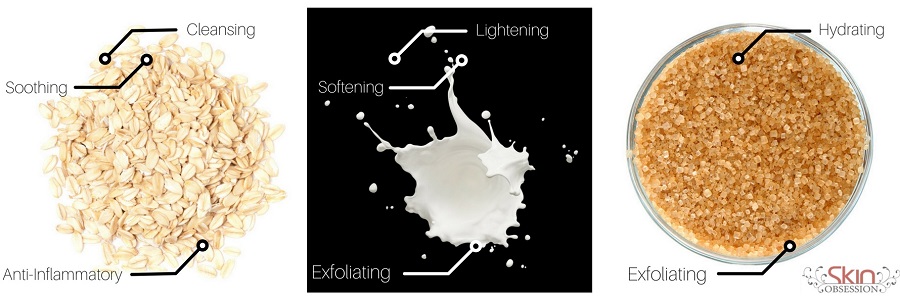Natural Alternatives to Chemical Peels
We carry a wide variety of chemical peels, each designed to address a unique set of issues. Below, we've broken down the function of a few of our chemical peel treatments and compared them to potential natural skin peel alternatives.
If you want smoother, more supple and more radiant skin, a chemical peel could be a great solution for you. Although natural products cannot completely mimic some of the stunning results you'll see with chemical peels, there are plenty of natural substitutions available that will effectively rejuvenate your skin.
Whether you're reluctant to go all the way with a peel, or you're simply looking for a natural skin exfoliant in-between treatments, let's explore some at-home products you can utilize.
Alpha Hydroxy
The alpha hydroxy acids group includes lactic acid as well as glycolic acid. An alpha hydroxy, or AHA, remains on surface of the skin where it removes oil-soluble impurities, exfoliating from the top rather than penetrating into pores. AHAs are derived from sugars - lactic acid from milk and glycolic acid from sugar cane, and work well on thick or sun-damaged skin. Because they are superficial, they compare to scrubs more than other acids. Some natural ingredients that can lightly mimic an AHA are oatmeal, sugar and buttermilk. These ingredients are mild in nature and can be used for all skin types.
 Oatmeal
Oatmeal contains a class of chemical compounds called saponins. These compounds have cleansing properties, which makes oatmeal a great ingredient for skincare. Additionally, oatmeal contains phenols, which have anti-inflammatory properties and provide protective benefits for sensitive or irritated skin.
The benefits oatmeal can provide for your skin are most effective when this ingredient is used as a colloid. Simply put, a colloid consists of small particles suspended in a solution. You can create your own oat colloid by tossing some (non-instant) rolled oats into a foot processor and then mixing your powder with water. Try adding additional ingredients such as honey, lavender or avocados for a cleanser or mask with even more benefits.
Sugar gently exfoliates, making it a comparable replacement for a light AHA peel. Although peeling and exfoliating are not the same, the exfoliating properties of a sugar scrub can leave your skin just as smooth and radiant. Exfoliating sloughs away dead skin which increases cell turnover to create a fresher and younger-looking you.
Unlike salt, which is microscopically jagged, sugar has rounded edges and offers hydrating qualities.
To create a sugar scrub, combine a coarse raw sugar of your choice with a non-comedic (won't clog pores) oil such as jojoba, castor or sweet almond. We recommend that you avoid comedogenic oils such as coconut, flax seed and linseed, especially if you're prone to breakouts.
The exfoliating properties of sugar combined with the hydrating and nourishing properties of a healthy oil will ensure absolutely radiant results.
Try infusing your sugar scrub with essential oils, dry flowers or herbs!
Like all
dairy products, buttermilk contains lactic acid. However, unlike other dairy products, buttermilk contains lactic acid in high enough concentrations to actually provide exfoliating results. In addition to creating softer and smoother skin through exfoliation, lactic acid can also lighten, soften and control oil production.
Lactic acid is produced by bacteria that include including Lactobacillus and Streptococcus. These bacteria live in yogurt and kefir as well as milk. For maximum benefits, use minimally processed, whole-fat products that aren't flavored or sweetened.
Beta Hydroxy
The beta hydroxy acids group includes salicylic acid, a common ingredient found in acne washes and creams. Beta hydroxies, or BHAs, are exfoliants that are able to penetrate into the skin, cleaning out dirt and oil from pores in the process. By dissolving the upper layer of the skin while unclogging pores, BHAs effectively fight breakouts, acne and dull or oily skin.

Salicylic acid is available in a variety of facial cleansers, capable of effectively battling breakouts over the counter in low concentrations. Other ingredients that compare to the powers of salicylic acid include apple cider vinegar and citric acid.
Apple cider vinegar is an affordable solution made from apples by a two-step fermentation process. The result is an acetic acid with antibacterial properties. In addition, a vinegar solution also offers pH-balancing benefits. Dilute vinegar and water at a 1:1 ratio to create an exfoliating and restorative toner.
Similar to vinegar, citric acid is another ingredient that can clean pores and keep bacteria at bay. Citric acid can be found in lemons and oranges.
Citric acids can upset skin's pH, creating the potential for irritation as well as increased sensitivity to sunlight. If you use this ingredient, we recommend following it up with a toner to restore the balance of your skin.
In addition to removing oil and skin cells from pores to reduce the incidence of breakouts, try incorporating antibacterial agents such as honey or tea tree oil into your skin care routine.
Honey is a natural antibacterial agent, but it is also nourishing and hydrating. While it does not provide exfoliating benefits on its own, you can create a well-rounded exfoliating cleanser by combining honey with oats or sugar.
Tea tree oil rids skin of bacteria as well as fungus. It can be used as part of your acne skin care regimen or to treat small cuts, rashes or dandruff.
Think you might be ready for a more in-depth treatment? Take this quick and simple quiz to learn which chemical peel is right for you!